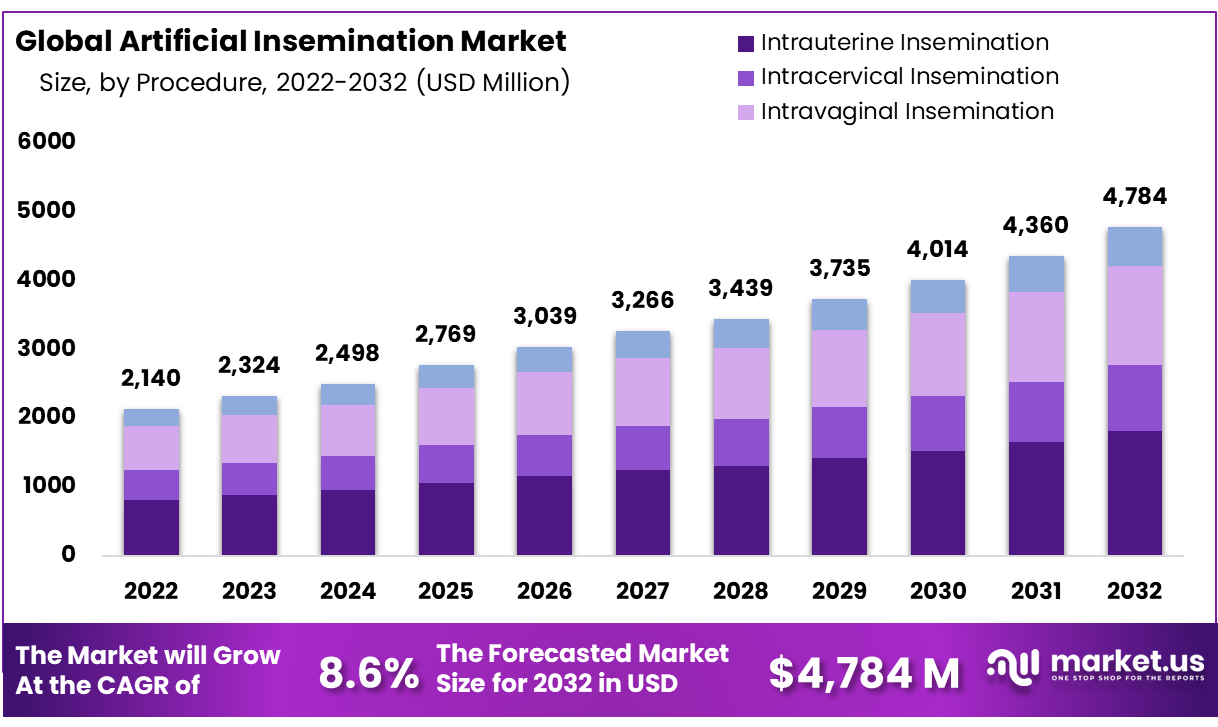The global artificial insemination market is showing steady growth. According to a report by Market.us, the market is projected to reach USD 4,784 million by 2032. This is up from USD 2,140 million in 2022, growing at a CAGR of 8.6% between 2023 and 2032. One of the main drivers behind this rise is the growing issue of infertility worldwide. The World Health Organization (WHO) reports that about one in six people will experience infertility in their lifetime. As a result, many couples are turning to artificial insemination as a more affordable and less invasive fertility option.
Delayed parenthood is further fueling market growth. Many people are choosing to have children later in life due to career goals or financial stability. However, age-related fertility decline is common. In urban areas especially, where access to clinics is better, artificial insemination offers a practical solution. This shift in social behavior is playing a big role in expanding the market for fertility services.
Government support is also boosting market expansion. Several countries provide funding or insurance coverage for infertility treatments. For example, certain European nations and provinces in Canada offer subsidies for artificial insemination. These financial policies help make treatment more accessible and affordable for a wider group of people. This kind of support increases both awareness and participation in reproductive health programs. Lastly, medical advancements are making artificial insemination safer and more successful. Innovations in reproductive technology are improving success rates and lowering health risks. Public health bodies encourage ongoing research and innovation in this area. In addition, veterinary artificial insemination is growing rapidly.

Key Takeaways
- A market analyst revealed that the global Artificial Insemination Market is expanding steadily, with a CAGR of 8.6% projected from 2023 to 2032.
- According to global health reports, infertility impacts roughly 17.5% of the adult population worldwide—about one in every six adults faces fertility challenges.
- Experts confirm that Intrauterine Insemination (IUI) remains the most commonly used procedure, holding the largest market share among assisted reproductive techniques.
- Industry observers noted that Artificial Insemination of the Husband (AIH) is projected to dominate the source type segment with the highest market share.
- A recent healthcare study found that fertility clinics generated the highest revenue among all end-users in the Artificial Insemination market in 2022.
- Researchers stated that newer technologies are making artificial insemination more effective and tailored, boosting success rates and improving patient satisfaction.
- Analysts observe that fertility tourism is growing, with many patients traveling abroad for advanced and more affordable artificial insemination procedures.
GET SAMPLE REPORT : https://market.us/report/artificial-insemination-market/request-sample/
Regional Analysis
Based on region, the global artificial insemination market is segmented into North America, Western Europe, Eastern Europe, Asia Pacific, Latin America, and the Middle East & Africa. Among these, North America held the highest revenue share of 39% in 2022. This dominance is due to the presence of advanced medical technologies and strong government support. Insurance coverage for fertility treatments has also improved access. Additionally, the rising adoption of assisted reproductive technologies (ART) such as artificial insemination supports market growth in the region.
The growth of the North American market is also driven by increased awareness about fertility options. Many couples are opting for early diagnosis and advanced fertility procedures. The availability of specialized clinics and experienced professionals has further fueled this trend. Moreover, favorable healthcare policies and growing acceptance of non-traditional family structures contribute to the demand. The rising average age of first-time parents in countries like the U.S. is another factor boosting market expansion.
In Europe, the artificial insemination market has also seen notable revenue growth. This is primarily due to rising infertility challenges among couples. According to the European Society for Human Reproduction and Embryology, around 25 million European couples are expected to face infertility by 2025. This alarming figure highlights the growing need for reproductive support. As a result, many couples are turning to minimally invasive fertility solutions like artificial insemination to achieve successful pregnancies.
To meet the rising demand, key players in Europe are investing heavily in research and development. This helps improve treatment success rates and lower risks. Governments in several European countries are also offering partial or full reimbursements for fertility treatments. This financial support boosts accessibility and patient adoption. Furthermore, technological advancements and growing societal acceptance are shaping a favorable environment. These factors collectively drive the strong growth of the artificial insemination market across Europe.
Conclusion
In conclusion, the artificial insemination market is growing steadily due to rising infertility, greater awareness, and improved medical technologies. More people are exploring this option as it is less invasive, more affordable, and widely available in urban areas. Social acceptance is also increasing, making it easier for single women and LGBTQ+ couples to access fertility care. Government support and better access to information are helping reduce stigma and improve treatment choices. With ongoing innovations in fertility clinics and the growing use of donor sperm, artificial insemination is becoming a trusted solution for many. This trend is expected to continue as more people seek safe and effective ways to start families.



